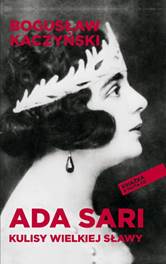
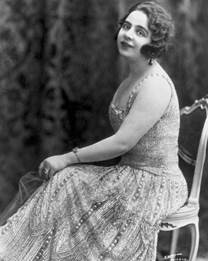
ADA SARI kulisy wielkiej slawy by Boguslaw Kaczynski


Casa Grande 2017
ISBN 978-83-927451-6-7383
383 pp + 1 CD
Ada Sari (1886 – 1968) born Jadwiga Szayer was a Polish coloratura soprano who is now sort of forgotten outside of Poland though the German Preiser label once issued a CD of her recordings. In the Polish opera world she is still a big name not only because of her very successful career but also because of her career as a teacher. She sang at the best European opera houses and concert halls during the fist half of the 20th century and her signature roles included Rosina, Gilda, Lakmé, Lucia and Violetta; parts from which she also recorded the main arias. (click on the highlited roles to listen to her recordings)
Sari made her professional opera debut in 1909 as Marguerite in Gounod’s Faust the Teatro Nazionale in Rome. She spent the next three years appearing at major opera houses in Italy. In early 1914 Sari gave a highly lauded portrayal of Gilda at the Great Theatre in Warsaw. In the spring of 1914 Sari embarked on a lengthy concert tour of Russia with a group of Italian singers which included extended stays in Moscow and Saint Petersburg for opera performances at the Mariinsky and Bolshoi theatres. The tour, which originated in Warsaw, also stopped for performances in Lembreg, Kiev, and Kraków.
While Sari was on tour, World War I broke out and the soprano decided to accept a contract at the Vienna State Opera in the Fall of 1914 as that city was not facing any immediate military threat. She left there in the Fall of 1916 to join the roster of singers at the opera house in Lviv. After a year there she returned to the Great Theatre, Warsaw where her portrayals included Lucia, Marguerite de Valois and Konstanze.
After World War I ended, Sari performed a lot in South America, especially since 1918 at the Colon (Rosina) in Buenos Aires. In 1921 she undertook a concert tour throughout North America, which included appearances at Carnegie Hall in New York and the Auditorium theatre in Chicago. Toscanini invited her to portray the Queen of the Night in Zauberflote for the opening of La Scala's 1923-1924 season.
In 1934 she moved back to Warsaw, where she sang frequently at the Wielki Theatre. During the Second World War she directed an opera studio in Warsaw, and after the war she sang with the opera companies in Wrocław and Kraków, as well as giving concerts and broadcasts. While still performing, she began to teach in 1936. Many well-known singers such as Halina Mickiewiczówna, Bogna Sokorska, Urszula Trawińska-Moroz, Maria Foltyn, Barbara Nieman, Zdzislawa Donat and numerous others graduated from her class.
She died at the age of 82 during a stay in a sanatorium in Ciechocinek in 1968.
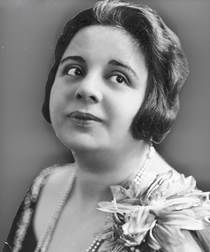
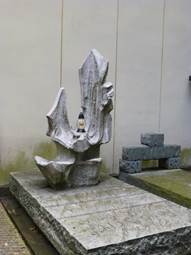 (Sari's tomb in Warsaw)
(Sari's tomb in Warsaw)
Only the good die too young. Boguslaw Kaczynski (1942-2016) author of the book –and who knew the singer personally - passed away in Warsaw a year ago from a heart attack. He was an authority on Polish vocal/operatic art and the driving force behind the firm Casa Grande specializing in preserving Poland’s operatic past. Ada Sari was his last project.
The book obviously written in Polish nevertheless has some redeeming features for non-Polish speakers including the numerous high quality photos. The several chapters’ titles include the story of her family, her stays in Vienna, Milan and the Italian peninsular, her Russian tour, the first world war period, the peak of her fame, prima donna coloratura at la Scala, the modern Patti, near the Titicaca lake, as these birds fly; in Europe and America, final chord, her teaching method, Ada Sari as a teacher, her students and Ada Sari remembered.
The Sari story is illustrated with several reviews from her performances and several of her former students wrote down their memories of her as a teacher. There is a survey of all her appearances in Warsaw, a four page repertory list and a complete discography of her 78’s for HMV, Polydor and Grammophon.
The accompanying compact disc includes arias from Barbiere, Lucia, Rigoletto, Traviata, Lakmé and concert pieces by Adam and Johan Strauss. But the most interesting track contains her memories of Toscanini in fluent Italian (!!) for the Rome radio.
RECORDINGS
Click here to listen to Ada Sari in I Puritani + here
Click here to listen to Ada Sari in Sonnambula
Click here to listen to Ada Sari in Louise (in French)
Click here to listen to Ada Sari in a Wietold Friemann song (rare)
Click here to listen an acetate record of O sole mio made late in her career
Click here to listen to a documentary (Polish only) on Ada Sari + here
Rudi van den Bulck, November 2017
A few more words and photos regarding Ada Sari provided by Liliana Osses Adams
A little bit about Ada Sari (June 29, 1886 – July 12, 1968)
When Jadwiga Leontyna Szayer was three years old, the family moved from Wadowice (Jadwiga’s birth place) to Stary Sącz in the rural community (gmina) district of Stary Sącz.
The annual Ada Sari International Vocal Artistry Festival and Competition takes place in the city of Nowy Sącz, district capital of Nowy Sącz County (hrabstwo).
From 1889 the Szayer family lived in a modest house at Sobieskiego Street, no.16 in Stary Sącz.
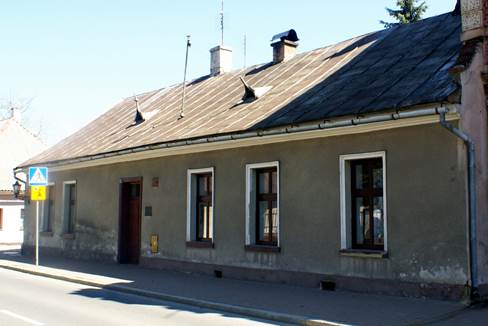
(Ada Sari House at Stary Sącz, Sobieskiego 16)
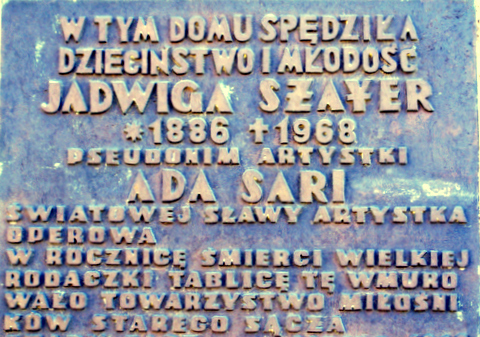
(Commemorative plaque of Jadwiga Szayer – Ada Sari House)
For the next 17 years, her father Edward Szayer (1856- 1940), well-known lawyer, educated at the Jagiellonian University in Krakow, served as the mayor of Stary Sącz. He built an adjacent two story red brick house at Sobieskiego Street, no. 18 in Stary Sącz, for Jadwiga’s siblings, a sister and four brothers.
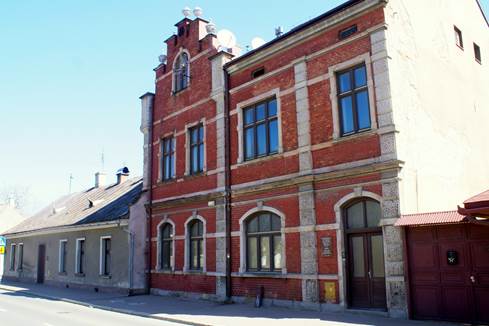
(Dr Edward Szayer’s Family House, Sobieskiego 18 in Stary Sącz)
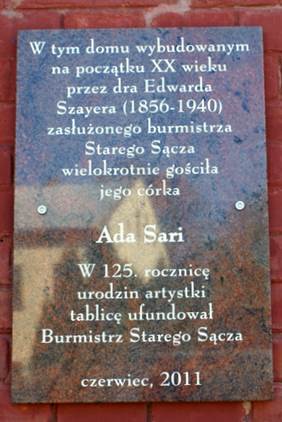
(Commemorative plaque dr Edward Szayer, June 2011)
After an initial education at the Catholic school in Stary Sącz, operated by the Sisters Clarisses from the Order of Saint Claire, Jadwiga Szayer was admitted to a private school for girls in Vienna, established by Italian Countess Pizzamano and patronized by benefactress, the Princess of Liechtenstein, where she began to learn how to sing and dance, how to draw and embroider, to learn French, etiquette and good manners, and became au courant with fashion trends and fine cuisine.
Soon after she was chosen to sing the title aria of “La Poupée” by Edmond Audrian at the Viennese Prater.
And thus, the phenomenal career began…
Never being married, she thought of her art as a sublime and divine priesthood and not only as a sort of sacrifice.
In September 23 and 25, 1926, she made her guest appearances at Poznań Opera, Teatr Wielki as Violetta and Gilda.
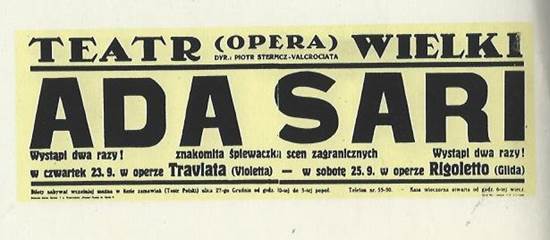
(Source: Poster in 1970 Poznań Publication “Opera Poznańska 1919-1969”, p. 138)
From 1936 Ada Sari began to teach in her underground opera studio in Warsaw. Retired from the stage in 1947, she devoted herself entirely to dozens of her pupils. She died in 1968 in Ciechocinek Sanatorium suffering acute heart failure leading to heart attack.
Many distinguished and recognized singers graduated from Professor Ada Sari’s voice faculty at Warsaw Academy of Music and from her private studio. The long list includes: Halina Mickiewiczówna de Larzac, Maria Fołtyn, Bogna Sokorska, Urszula Trawińska-Moroz, Barbara Niemen, Zdzisława Donat, Vittoria Calma (b. Wiktoria Kotulska-Castro), Janina Stano (b. Janina Głodzińska), Halina Szymulska, Jerzy Karolus, Marian Woźniczko, and Adelina Gallert-Rühm, my friend, who died in 2006. Adelina made her debut at Bytom Opera as The Queen of the Night in Mozart’s The Magic Flute. She was married to Austrian composer Gerhard Rühm, who studied with Josef Matthias Hauer, an Austrian precursor of dodecaphony (twelve-tone technique.) Adelina and Gerhard did some recordings of Hauer’s Sieben Kleine Stücke für Klavier, op.3 and 6.
Karl Maramorosch (1915 – 2016), an eminent Austrian-born American scientist, virologist, entomologist and plant pathologist, who received the Wolf Prize in Agriculture (established in Israel) for his pioneering and wide-ranging studies on interactions between insects and disease agents in plants, wrote the following passage of Ada Sari in his Memoir “The Thorny Road to Success” in the chapter entitled “Vienna, Prague, Paris, and Stockholm, 1946”:
“Before we left Vienna, an opera performance of Aida was announced with Ada Sari in the role of Aida. Ada Sari was of Polish origin, and in 1946, she was already quite old. When she started singing, her voice failed, and she stopped and left. After a short commotion, a young singer continued in the role of Aida. While this last public appearance of Ada Sari was traumatic for her and those in the audience who remembered her from earlier days, the substitute singer got her first chance to appear before the Vienna public. A few years later she became well known not only in Europe but also at the Metropolitan Opera. (1)
When we boarded the bus to Brno, we were surprised to see Ada Sari among the passengers. It so happened that we were sitting next to her, and I told her that I recognized her, and was thrilled to meet her. She asked whether I had been in the audience when she appeared in Vienna, and I did not admit it. She seemed relieved and soon fell asleep. We arrived in Brno around ten o’clock at night and immediately went to a restaurant to have dinner. For the first time, after more than six years, we ate Wiener schnitzel (a known specialty of Viennese cuisine) and potatoes prepared the way we remembered from our days in Poland.”
(Published by iUniverse, Bloomington, Indiana. Copyright by Karl Maramorosch, 2014, 2015)
(1) Dr Maramorosch memory obviously failed him -but only partly so- Sari sang indeed her last stage performance in Vienna but not as Aida but as Gilda. Her substitute was Emmy Loose. Click here for details